The Healing Help of Helichrysum
If there was ever liquid gold in a bottle, it’s name would be Helichrysum.
Mostly known for its skin regenerative qualities, it is also helpful for the digestive, musculoskeletal and nervous system.
“Its effects are so convincing that it has never met with any kind of criticism despite the absence of data on its effectiveness. Helichrysum oil demonstrates that anecdotal evidence can create a reality without the help of industrially sponsored science. Helichrysum is more predictable in its action than almost any other oil and is produced and sold by small enterprises that understand the needs of the aromatherapy market.” Kurt Schnaubelt, Ph.D. (1)
The name Helichrysum is derived from the Greek words ἑλίσσω (helisso,Sun) and χρῡσός (chrysos, gold).
There are an estimated 600 species within the Helichrysum genus. Helichrysum grows on dry, rocky or sandy ground around the Mediterranean region and is native to coastal France, Italy, and Croatia. The stems are woody at the base, reaching 2 feet or more in height. In the summer, they produce clusters of yellow flowers that retain color after picking and are used in dried floral arrangements.
d
Helichrysum italicum (synonym Helichrysum angustifolium) is steam distilled to produce a yellow-reddish essential oil which has grown popularity across the world in skin care products, colognes and perfumes. Other common names of Helichrysum include Italian strawflower, immortelle, and everlasting.
Aroma
The aroma of Helichrysum is unique and unusual. Rubbing the flowers of the Mediterrean shrub give off a curry-like scent. After distillation, the oil is best described as herbaceous, sweet, and honey-like. Some describe the scent of helichrysum as honey on warm toast while others describe it as dusty old clothes. (2) For me, the scent of helichrysum italicum reminds me of being on a country hilltop on a warm summer day.
Principal Constituents
It’s true liquid gold and high in the constituent neryl acetate (30-50%) which is extremely sensitive to climate changes. There are forty-five unique components that make up around 90% of Helichyrusum italicum essential oil. Besides neryl acetate other principal constituents are geraniol, pinene, linalol and sesquiterpinols (ar-curcumene, eudesmols and y-curcumerne) and diketones.
Uses
Helichrysum oil is a popular ingredient in herbalist skincare products, particularly those for supporting wound healing. Helichrysum italicum hydrosol (pH 3.5-3.8) also beneficial for cleaning and promoting healing of the skin. The oil helps to maintain healthy skin, rejuvenates skin, reducing the appearance of uneven skin texture and tone when applied topically. It is a mild oil and great for supporting sensitive skin. Generally, it is best used in dilution (low concentration). For most of its intended purposes it is equally as effective in a 1% dilution as it would be at higher concentrations. (3). Given its efficacy in smaller quantities, this makes it more affordable.
“Immortelle oil has a strong psychological effect, emotionally warming and opening. It supports deep abdominal breathing and the scent has a relaxing, elevating effect on the mind. The scent of is also thought to increase dream activity and awareness, and to stimulate the right (intuitive) side of the mind. This makes it of use in meditation, active imagination and the creative arts”. (4). - Julia Lawless
It is also helpful in soothing tension both physically and emotionally. Inhaling Helichrysum can be helpful during periods of mental unrest, irritability, grief, anger, anxiety and burnout.
Safety: Non-irritant, non-sensitizing. No contraindications (5)
Blends well with: geranium, clary sage, rose, lavender, carrot seed, german chamomile, rosemary, sage, roman chamomile and citrus oils.
Applications and Methods of Use:
Use in bath to relieve stress. Add 1-2 drops directly to bath gel and hold under warm water when bath water filling or add bath gel and helichrysum mixture to Epsom salts.
Diffuse for aromatherapy benefits through inhalation. (Great for yoga, meditation and visualization)
Use in massage blends, e.g. 2 drops of helichrysum and lavender in 1 tablespoon base oil to induce relaxation.
Use in essential oil roller to promote skin healing. (see recipe below)
Disclaimer: This blog is for general informational purposes only and does not constitute the practice of medicine, nursing or other professional health care services, including the giving of medical advice. The use of information on this blog or materials linked from this blog is at the user's own risk. The content of this blog is not intended to be a substitute for professional medical advice, diagnosis, or treatment. Users should not disregard, or delay in obtaining, medical advice for any medical condition they may have, and should seek the assistance of their health care professionals for any such conditions.
References:
Schnaubelt, Kurt, Ph.D. (1999). Medical Aromatherapy. Berkely, CA: Frog, Ltd.
Catty, Suzanne. (2001). Hydrosols the next aromatherapy. Rochester, VT: Healing Arts Press.
Schnaubelt, Kurt, Ph.D. (2011). The Healing Intelligence of Essential Oils. Rochester, VT: Healing Arts Press.
Lawless, Julia. (1998). Aromatherapy and the Mind. Hammersmith, London: Thorsons.
Tisserand, Robert (2014) Essential Oil Safety, 2nd Edition. Churchill Livingstone Elsevier



